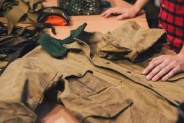Innovation and progression are popular buzzwords to describe outdoor gear. Each new product release is positioned as a breakthrough, an innovation or a monumental step forward in the world of hiking boots, technical outerwear, ski gear and more.
But in this innovation arms race, classic materials like wool hold their own. In fact, I’d go a step further to say that wool remains the best material for outdoor apparel.
I’m not alone: brands like Filson, Icebreaker and Arc’teryx have dedicated themselves to producing high-end, quality wool products that will stand the test of time. This is why.
Wool is naturally insulating
Sheep grow wool as a natural protective barrier against cold (and heat, but we’ll get to that later) and it’s hard to argue with the logic of nature. Wool insulates so well thanks to its structure: each wool fiber is composed of protein molecules, which trap air and moisture, keeping skin temperature stable.
Because it’s breathable, wool allows moisture vapor to escape while retaining heat. Unlike cotton, which traps moisture against the skin and in turn makes you feel colder, wool can absorb more than 30 percent of its weight before it becomes damp, making it an ideal material for baselayers.
A common misconception with wool is that it’s only for cold temperatures. Wearing a thin layer of wool on a hot day can actually help you beat the heat.
A common misconception with wool is that it’s meant to be worn only in cold temperatures. Thick, wool will overheat you in warmer temperatures. However, wearing a thin layer of wool on a hot day can actually help you beat the heat. Wool is moisture-wicking, quick drying and helps regulate skin temperature; these are all qualities you’d want in a summer sun shirt.







